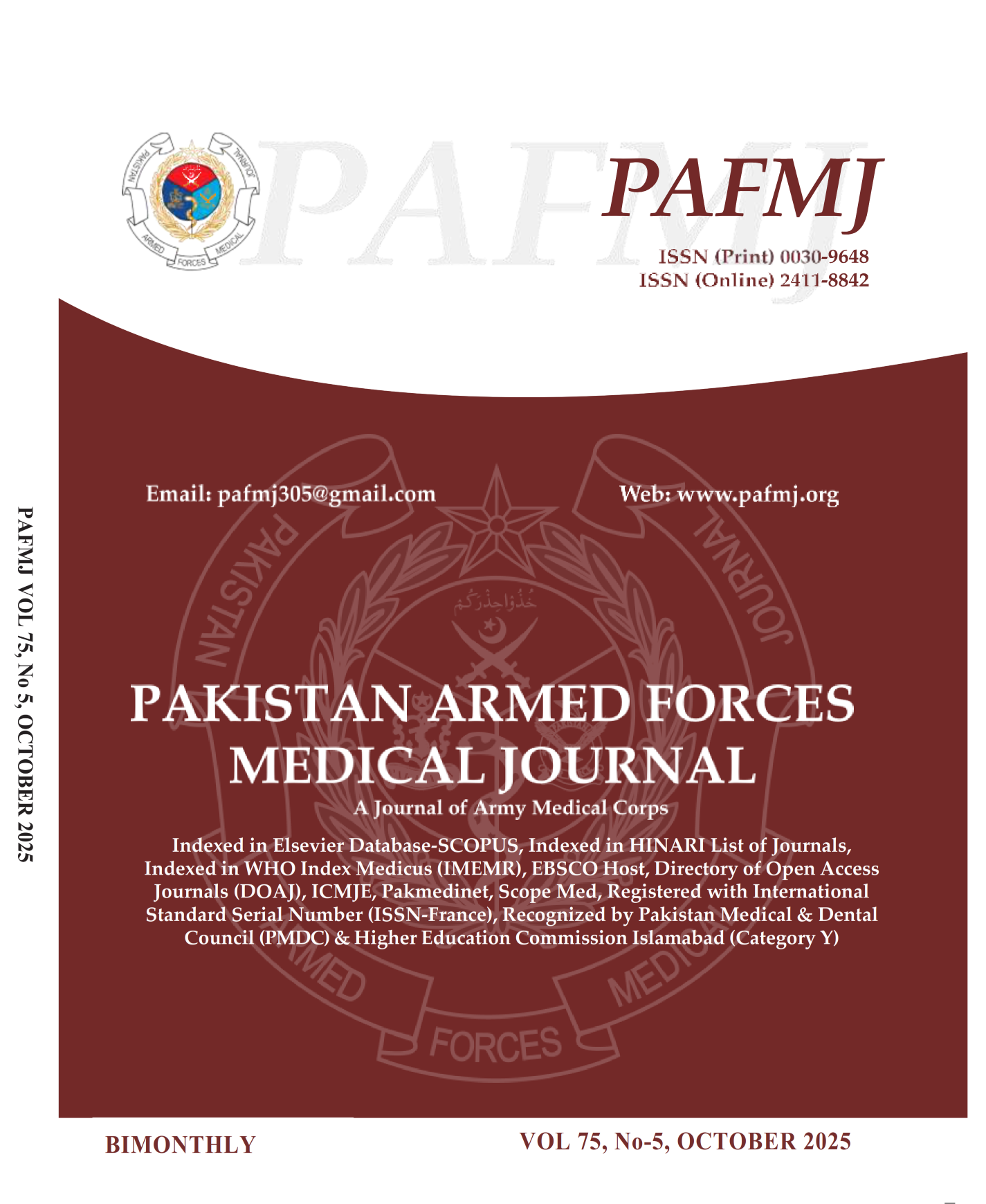Utility of Monitoring Renin And Aldosterone Levels In Determining Efficacy of Chemotherapy
DOI:
https://doi.org/10.51253/pafmj.v75i5.9143Keywords:
Aldosterone, Angiotensin-Converting Enzyme Inhibitors, Anthracyclines, Brain Natriuretic Peptide, ReninAbstract
Objective: To determine the clinical utility of renin and aldosterone levels in cancer patients treated with combination of ACE inhibitors and anthracyclines
Study Design: Quasi-experimental study
Place and Duration of Study: Department of Chemical Pathology, Armed Forces Institute of Pathology (AFIP), Rawalpindi, Pakistan, from Jul to Dec 2020.
Methodology: Patients of either gender, aged between 40-70 years, who were diagnosed with various malignancies and were on anthracyclines as part of chemotherapy for last six months were enrolled and further divided into two groups. Group I patients were given anthracyclines alone, Group II patients were given ACE (Angiotensin-Converting Enzyme) inhibitors along with anthracyclines. Samples were collected and analyzed for Active Renin Concentration (ARC), plasma aldosterone, troponin I and N-terminal pro-B-type natriuretic (NT-proBNP) peptide. Mean values of these parameters amongst two groups were compared by applying independent sample t test where p-value ≤ 0.05 was considered as significant.
Results: Out of 195 patients 114(58.5%) were in Group I and 81(41.5%) were in Group II. Mean values of plasma aldosterone (799.84 ± 56.88 pmol/L vs 430.59±62.36 pmol/L), ARR (Aldosterone-to-Renin Ratio) (46.24±21.80 pmol/mIU vs 25.77±7.10 pmol/mIU), Pro BNP (125.26±10.61 pg/ml vs 87.77 ± 8.76 pg/ml) and trop I (0.06±0.011 ng/ml vs 0.04±0.007 ng/ml) were higher in Group I as compared to Group II. The difference among means of each parameter amongst two groups was found to be statically significant (p-value≤ 0.05).
Conclusion: Plasma aldosterone, ARR, Trop I and NT pro BNP levels can be used for monitoring and early detection of Anthracycline-Induced Cardiomyopathy (AIC).
Downloads
References
1. Cao W, Chen H-D, Yu Y-W, Li N, Chen W-Q. Changing profiles of cancer burden worldwide and in China: a secondary analysis of the global cancer statistics 2020. Chin Med J 2020; 134(7): 783–791.
https://doi.org/10.1097/CM9.0000000000001474
2. Gulland A. Global cancer prevalence is growing at “alarming pace,” says WHO. BMJ 2014;348:g1338.
https://doi.org/10.1136/bmj.g1338
3. Sarwar MR, Saqib A. Cancer prevalence, incidence and mortality rates in Pakistan in 2012. Cogent Med 2017;4(1):1288773.
https://doi.org/10.1080/2331205x.2017.1288773
4. Dolci A, Dominici R, Cardinale D, Sandri MT, Panteghini M. Biochemical markers for prediction of chemotherapy-induced cardiotoxicity: systematic review of the literature and recommendations for use. Am J Clin Pathol 2008;130(5):688–695.
https://doi.org/10.1309/AJCPB66LRIIVMQDR
5. Akpek M, Ozdogru I, Sahin O, Inanc M, Dogan A, Yazici C, et al. Protective effects of spironolactone against anthracycline-induced cardiomyopathy. Eur J Heart Fail 2015;17(1):81–89.
https://doi.org/10.1002/ejhf.196
6. Blanter JB, Frishman WH. The preventive role of angiotensin converting enzyme inhibitors/angiotensin-II receptor blockers and β-adrenergic blockers in anthracycline-and trastuzumab-induced cardiotoxicity. Cardiol Rev 2019;27(5):256-259.
https://doi.org/10.1097/CRD.0000000000000234
7. Ali D, Naqvi SBS, Nasiri MI, Ahmed K, Zaheer K, Azeem M, et al. Evaluation of prevalence of different types of cancer and its chemotherapy in various ethnic groups of Pakistan: A retrospective study. Braz J Pharm Sci 2020;56:e18915.
https://doi.org/10.1590/s2175-97902020000118915
8. World Health Organization. Cancer. 2022. Available from: https://www.who.int/en/news-room/fact-sheets/detail/cancer
9. Pavlidis N. Chemotherapy. ESMO; 2019. Available from: https://oncologypro.esmo.org/content/download/233711/3944768/file/2019-ESMO-ESO-Course-Valencia-Chemotherapy-Nicholas-Pavlidis.pdf
10. Hulst MB, Grocholski T, Neefjes JJC, van Wezel GP, Metsä-Ketelä M. Anthracyclines: biosynthesis, engineering and clinical applications. Nat Prod Rep 2022;39(4):814–841.
https://doi.org/10.1039/d1np00059d
11. Giordano SH, Lin Y-L, Kuo YF, Hortobagyi GN, Goodwin JS. Decline in the use of anthracyclines for breast cancer. J Clin Oncol 2012;30(18):2232–2239.
https://doi.org/10.1200/JCO.2011.40.1273
12. Nabhan C, Byrtek M, Rai A, Dawson K, Zhou X, Link BK, et al. Disease characteristics, treatment patterns, prognosis, outcomes and lymphoma-related mortality in elderly follicular lymphoma in the United States. Br J Haematol 2015;170(2):85–95.
https://doi.org/10.1111/bjh.13399
13. Chihara D, Westin JR, Oki Y, Ahmed MA, Do B, Fayad LE, et al. Management strategies and outcomes for very elderly patients with diffuse large B-cell lymphoma. Cancer 2016;122(4):525–531.
https://doi.org/10.1002/cncr.29779
14. Smith LA, Cornelius VR, Plummer CJ, Levitt G, Verrill M, Canney P, et al. Cardiotoxicity of anthracycline agents for the treatment of cancer: systematic review and meta-analysis of randomised controlled trials. BMC Cancer 2010;10:337.
https://doi.org/10.1186/1471-2407-10-337
15. Meyer M, Seetharam M. First-line therapy for metastatic soft tissue sarcoma. Curr Treat Options Oncol 2019;20(1):6.
https://doi.org/10.1007/s11864-019-0606-9
16. Megías-Vericat JE, Martínez-Cuadrón D, Sanz MÁ, Poveda JL, Montesinos P. Daunorubicin and cytarabine for certain types of poor-prognosis acute myeloid leukemia: a systematic literature review. Expert Rev Clin Pharmacol 2019;12(3):197–218.
https://doi.org/10.1080/17512433.2019.1573668
17. Champoux JJ. DNA topoisomerases: structure, function, and mechanism. Annu Rev Biochem 2001;70:369–413.
https://doi.org/10.1146/annurev.biochem.70.1.369
18. Lyu YL, Kerrigan JE, Lin C-P, Azarova AM, Tsai Y-C, Ban Y, et al. Topoisomerase IIbeta mediated DNA double-strand breaks: implications in doxorubicin cardiotoxicity and prevention by dexrazoxane. Cancer Res 2007;67(18):8839–8846.
https://doi.org/10.1158/0008-5472.CAN-07-1649
19. Sobczuk P, Czerwińska M, Kleibert M, Cudnoch-Jędrzejewska A. Anthracycline-induced cardiotoxicity and renin-angiotensin-aldosterone system-from molecular mechanisms to therapeutic applications. Heart Fail Rev 2022;27(1):295–319.
https://doi.org/10.1007/s10741-020-09977-1
20. Gupta V, Kumar Singh S, Agrawal V, Bali Singh T. Role of ACE inhibitors in anthracycline-induced cardiotoxicity: A randomized, double-blind, placebo-controlled trial. Pediatr Blood Cancer 2018;65(11):e27308. https://doi.org/10.1002/pbc.27308
21. Wihandono A, Azhar Y, Abdurahman M, Hidayat S. The role of lisinopril and bisoprolol to prevent anthracycline induced cardiotoxicity in locally advanced breast cancer patients. Asian Pac J Cancer Prev 2021;22(9):2847–2853.
Downloads
Published
Issue
Section
License
Copyright (c) 2025 Sajjad Ali Haider, Zujaja Hina Haroon, Athar Iqbal Paracha, Afshan Bibi, Muhammad Wasi Nayyar, Uzma Ansari

This work is licensed under a Creative Commons Attribution-NonCommercial 4.0 International License.















